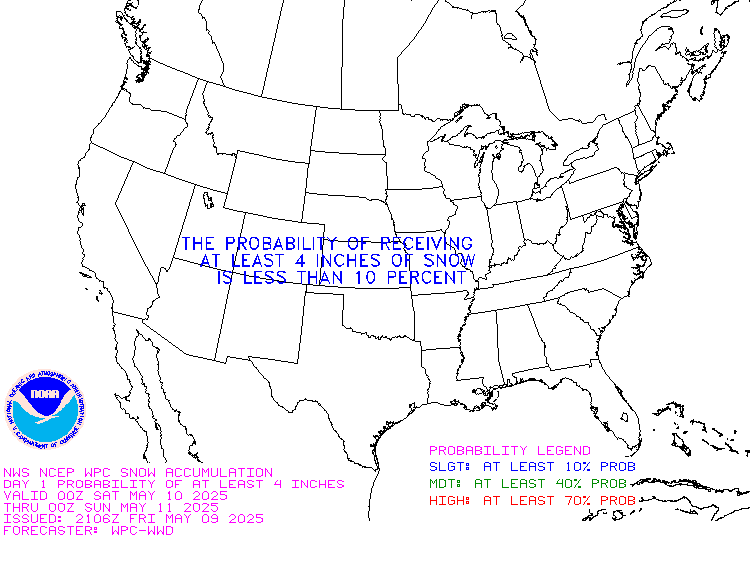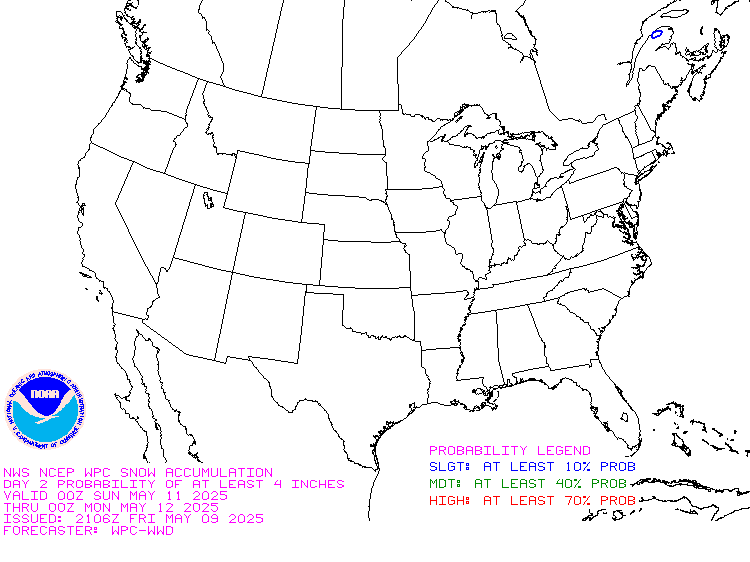It is difficult to find a more comprehensive Weather Outlook anywhere else with the ability to get a local 10-day Forecast also.
This article focuses on what we are paying attention to in the next 48 to 72 hours. The article also includes weather maps for longer-term U.S. outlooks and a six-day World weather outlook which can be very useful for travelers.
First the NWS Short Range Forecast. The afternoon NWS text update can be found here but it is unlikely to have changed very much. The images in this article automatically update.
Short Range Forecast Discussion
NWS Weather Prediction Center College Park MD
Tue Mar 19 2024
Valid 12Z Tue Mar 19 2024 – 12Z Thu Mar 21 2024…Lake effect snow continues across the Great Lakes before a developing
low pressure system spreads snowfall east into northern New England on
Wednesday……Light to moderate snow enters the northern Plains midweek and pushes
into the Upper Midwest on Thursday……Shower and thunderstorm chances return to the southern Plains and
western Gulf Coast…Cold northwest flow crossing over relatively warm lake waters will lead to
additional lake effect snow showers today, which will be further enhanced
as a low pressure system crosses from southern Ontario, Canada towards
Maine by early Thursday. Greatest probabilities for at least 4 inches of
snow exist across the eastern U.P. of Michigan and the Tug Hill Plateau of
western New York. As the low pressure system deepens over eastern Maine on
Thursday, additional snowfall is expected to develop just to its northwest
throughout northern Vermont, New Hampshire, and Maine. Medium
probabilities (40-70%) for at least 6 inches of snow is currently depicted
across this region. Gusty winds and below average temperatures are
forecast in the system’s wake, with highs only expected to reach into the
30s and 40s throughout the Great Lakes, Ohio Valley, and Northeast.Snow potential also returns to the northern Plains and northern Rockies on
Wednesday due to the combination of a nearby stationary front and
favorable jet stream dynamics. Far northwest Montana and the Yellowstone
region currently have the best chances for accumulating snow to add up to
over 4 inches. By Thursday, a developing low pressure system along the
aforementioned stationary front is anticipated to progress eastward across
the northern Plains and towards the Upper Midwest. This will spread light
to moderate snow from parts of the Dakotas to central/southern Minnesota,
far northern Iowa, and Wisconsin. Uncertainty remains on exactly where the
heaviest snowbands may set up, but residents should remain weather aware
and prepare for potentially difficult travel across the Upper Midwest
between Thursday night and Friday morning.For the southern Plains, rain and thunderstorm chances return on Wednesday
as an upper low lingering over the Southwest finally ejects eastward. A
few isolated thunderstorms could turn severe over western Oklahoma and the
Texas Panhandle, as well as south-central Texas. By Thursday, heavy rain
may develop along the Texas and Louisiana Gulf Coast, which could lead to
isolated flooding concerns.As far as the temperature highlights for the short term time period, a
frost/freeze threat remains this morning from the Lower Mississippi Valley
to the Southeast as lows dip into the 20s and 30s. This cold snap is
forecast to be short-lived as temperatures warm to near average by
Thursday across the South. Meanwhile, above average temperatures are
expected today across the central Plains and Northwest. Afternoon highs
could break daily temperature records throughout the northern Great Basin
as thermometer readings soar into the 70s.
To get your local forecast plus active alerts and warnings click HERE and enter your city, state or zip code.
Above is a 72 hour animation of the forecast. Learn about wave patterns HERE.
Then, looking at the world and of course, the U.S. shows here also. Today we are looking at precipitation.
Please click on “Read More” below to access the full Daily Report issued today.
| Notices: What would you like to learn about? Please provide that to me via the comment section at the end of the article. |
Now more detail on the 48-Hour Forecast (It is a 48 to 72 Hour Forecast actually)
Daily weather maps. The Day 1 map updates twice a day and the Day 2 and 3 maps update only once a day. These maps update automatically. But if that does not happen, you can get updates by clicking HERE
TODAY (or late in the day the evening/overnight map will appear) (Key to surface fronts shown on maps and you will then also be able to insert a city name or zip code and get a local NWS forecast).
TOMORROW
NEXT DAY
This animation shows how things may play out over the next 60 hours. To update click here.
The NWS Climate Prediction Center’s: Watches, Warnings, and Advisories plus other information can be found HERE. We post at least one of those updates daily, sometimes both. The Highlights are shown in the lede paragraph of this article.
ATMOSPHERIC RIVERS
This tells us what is approaching the West Coast. Click HERE to update If I have not gotten around to doing the update. Here is some useful information about Atmospheric Rivers.
Below is the current five-day cumulative forecast of precipitation (Updates can be found HERE)
Ski SnowReports
New Feature – Ski Reports. It is difficult to find reports that auto-update on-screen (and they are very long) but these links will get you to them – If you have additional suggestions make them in the comments section after every Econcurrents Article and we may add those links. We will try to not have too much overlap as that can add to the confusion.
Snow Forecasts. And remember this shows natural snow. Ski resorts also make their own snow.
Day 1

Day 2

Additional snow information can be found here, here, here, and here. The second link provides animations.
Now we look at Intermediate-Term “Outlook” maps for three time periods. Days 6 – 10, Days 8 – 14, and Weeks 3 and 4. An outlook differs from a forecast based on how NOAA uses these terms in that an “outlook” presents information as deviation from normal and the likelihood of these deviations.
Below are the links to obtain updates and additional information. They are particularly useful if you happen to be reading this article significantly later than when it was published. I always try to provide readers with the source of the information in my articles. These links may also be useful for those viewing this article on a cell phone or other small screen.
| Days 6 – 10 (shown in Row 1) | Days 8 – 14 (Shown in Row 2) | Weeks 3 and 4 (Shown in Row 3 but updates only on Fridays) |
| https://www.cpc.ncep.noaa. gov/products/predictions/610day/ | https://www.cpc.ncep .noaa.gov/products/predictions/814day/ | https://www.cpc.ncep.noaa.gov/products/predictions/WK34/ |
Showing the actual maps. They should now update automatically. The Week 3 – 4 Outlook only updates on Fridays. So below is what I call the Intermediate-term outlook. On Fridays, it extends out 28 Days. That declines day by day so on Thursday it only looks out 22 days until the next day when the Week 3 – 4 Outlook is updated and this extends the outlook by one additional week.
| 6–
10
|
|
|
| 8–
14 |
|
|
| 3–
4 |
|
|
HAZARDS OUTLOOKS
Click here for the latest complete Day 3 -7 Hazards forecast which updates only on weekdays. Once a week probably Monday or Tuesday I will update the images. I provided the link for readers to get daily updates on weekdays. Use your own judgment to decide if you need to update these images. I update almost all the images Friday Night for the weekend edition of this Weather Report. So normally readers do not need to update these images but if the weather is changing quickly you may want to.
Temperature month to date can be found at https://hprcc.unl.edu/products/maps/acis/MonthTDeptUS.png
Precipitation month to date can be found at https://hprcc.unl.edu/products/maps/acis /MonthPNormUS.png
World Forecast [that website is has been intermittent so be patient]
Below are the Day 1 -3 and 4-6 forecasts for temperature and precipitation. Updates and much additional information can be obtained HERE
World Temperature Anomalies
World Accumulated Precipitation
This information is provided by the University of Maine. They draw upon many different sources. There is a lot of information available at the link provided. I have just provided two useful forecasts. There are probably over a hundred different forecasts available from this source.
Worldwide Tropical Forecast (This is a NOAA Product)
This graphic updates on Tuesdays) If it has not been updated, you can get the update by clicking here Readers will only have to do that if they are reading this article much later than the date of it being published.
Information on Tropical Storms can be found HERE. Western Pacific information can be found HERE.
–
| I hope you found this article interesting and useful. |
–
